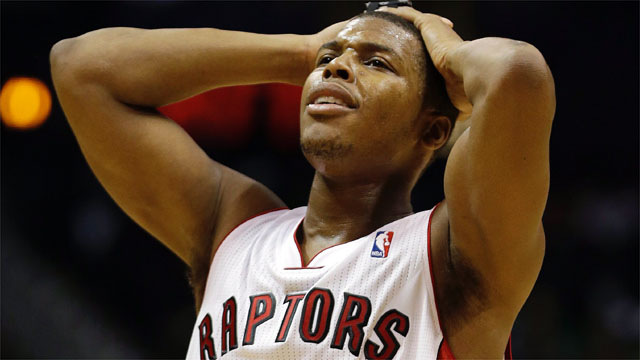If we bring the band back together, is there money left-over for groupies?
I can’t speak for the other writers, but I’m still too shell-shocked to look back at the playoffs, and the season as a whole. It felt like a rude awakening to a dream, and I’m in the midst of rubbing my eyes to see clearly. There will come a time to eulogize the 2013-14 Raptors. That time is the very near future. The stinging pain will give way to nostalgia, and we’ll reminisce fondly on what was undoubtedly one of the best seasons in franchise history.
But for now, let’s focus on more emotionally detached topics, like for example, the Raptors’ financial outlook.
The Bargnani and Rudy Gay trades really opened up financial flexibility. I trust I’m not breaking any ground there. When last season ended, the Raptors were on pace to be capped out this offseason, thanks in large part to Bargnani and Gay. At worst, assuming Gay picks up his player option, Salmons is bought out, Lowry, Vasquez and Patterson are let go (more on that in a second), jettisoning Gay and Bargs for their combined return netted roughly $20 million in savings.
More importantly, the trade puts the Raptors roughly $22 million under the cap (which is $63 million next season).
That figure assumes a few things:
- No draft picks are signed (not a realistic option)
- John Salmons is bought out ($7 million – $1 million buyout = $6 million)
- Dwight Buycks is waived ($0.8 million)
- Julyan Stone is waived ($0.9 million)
- Tyler Hansbrough bought out ($3.3 million – $1 million buyout = $2.3 million)
- Raptors renounce rights to Greivis Vasquez, Patrick Patterson and Kyle Lowry
The last point is particularly of note. Vasquez, Patterson and Lowry composed of 3/8ths of the Raptors’ rotation. Patterson is the lone floor-stretching big man on the roster, Vasquez was the only consistent play-maker off the bench and Lowry was the best player on the team. There’s no Arcade Fire without Win Butler and two of their extraneous tambourinists.
As an outsider who isn’t privy to insider sources, I can only speculate, but I think Ujiri wants to bring back all three. The haste of Dwane Casey’s extension sent one clear message — Ujiri likes the band, and wants an encore. Restoring the masthead was a clear signal of his confidence in this roster.
And if you don’t believe me (you really shouldn’t), heed the wiser words of Toronto Sun reporter Ryan Wolstat:
@william_lou They want them all back (UFAs and RFAs, likely not Salmons, 50 50 on Hansbrough)
— Ryan Wolstat (@WolstatSun) May 6, 2014
Given that player extensions cannot be signed until July 1st, there is plenty of time to project future contracts. More nuanced discussions are coming. As an assumption, I’ll just ball-park their average annual earnings at $4 million for Vasquez, $4 million for Patterson, and $12 million for Lowry.
A total of $20 million for the three leaves the Raptors capped out. If Hansbrough is retained, their draft picks are signed, and the remainder of the roster is filled out with minimum salaries, the Raptors would be slightly over the cap. The option of trading Hansbrough is always an option, given that his contract ($3 million expiring) is reasonable, but it’s largely a moot point. If the band is reuniting, the team will be capped out.
If Ujiri wants to make any additional upgrades through free-agency this offseason, he’ll have to turn to exceptions. At his disposal are both the mid-level and bi-annual exceptions. Had the Raptors paid the tax this season, they would only have $3 million available via the mid-level, but the Gay and Bargnani deals successfully tucked them under, which gives the Raptors the full $5 million for the MLE (those trades just keep on giving). The bi-annual exception totals $1.7 million.
Holding all else constant, the Raptors have some holes to fill. Most notably, as much as we derided him this season, John Salmons’ role will have to be filled. The playoff series against the Nets identified ball-handling and perimeter defense as roster weaknesses. With the full mid-level in hand, the price is right for a capable replacement. There’s not enough money for top-tier players like Luol Deng or Gordon Hayward, but there is enough for a players like Marvin Williams or Brandon Rush. Actually, there’s probably enough for both.
On the surface, this news is somewhat dour to those who feel that the Raptors need to a huge talent influx this offseason in order to take the next step in becoming a perennial playoff contender. It’s rather disappointing — the choice is to either dance with the new girl in town, or with the three girls who you came with.
However, there is still plenty of room to improve. In addition to the exceptions, the Raptors also have their first-round draft pick, and a two second-rounders (Sacramento and OKC’s). Also, despite the declining value of expiring contracts, the Raptors do boast three in Amir, Hayes and Fields. Paired with a draft pick or two, the opportunity to sign-and-trade is a possibility.
And of course, the biggest improvements are likely to come the offseason thereafter. Fields and Hayes’ contracts come off the books, which frees up a total of $12 million for the Raptors to play with. That’s when the Raptors, presumably operating with a more successful core (factoring improvements to DeRozan, Ross and Valanciunas), can splurge for a bigger name of Deng and Hayward’s ilk. But in the meantime, the Raptors still have a few bullets in the chamber, even after reloading Vasquez, Patterson and Lowry. The show must (and can) go on.



